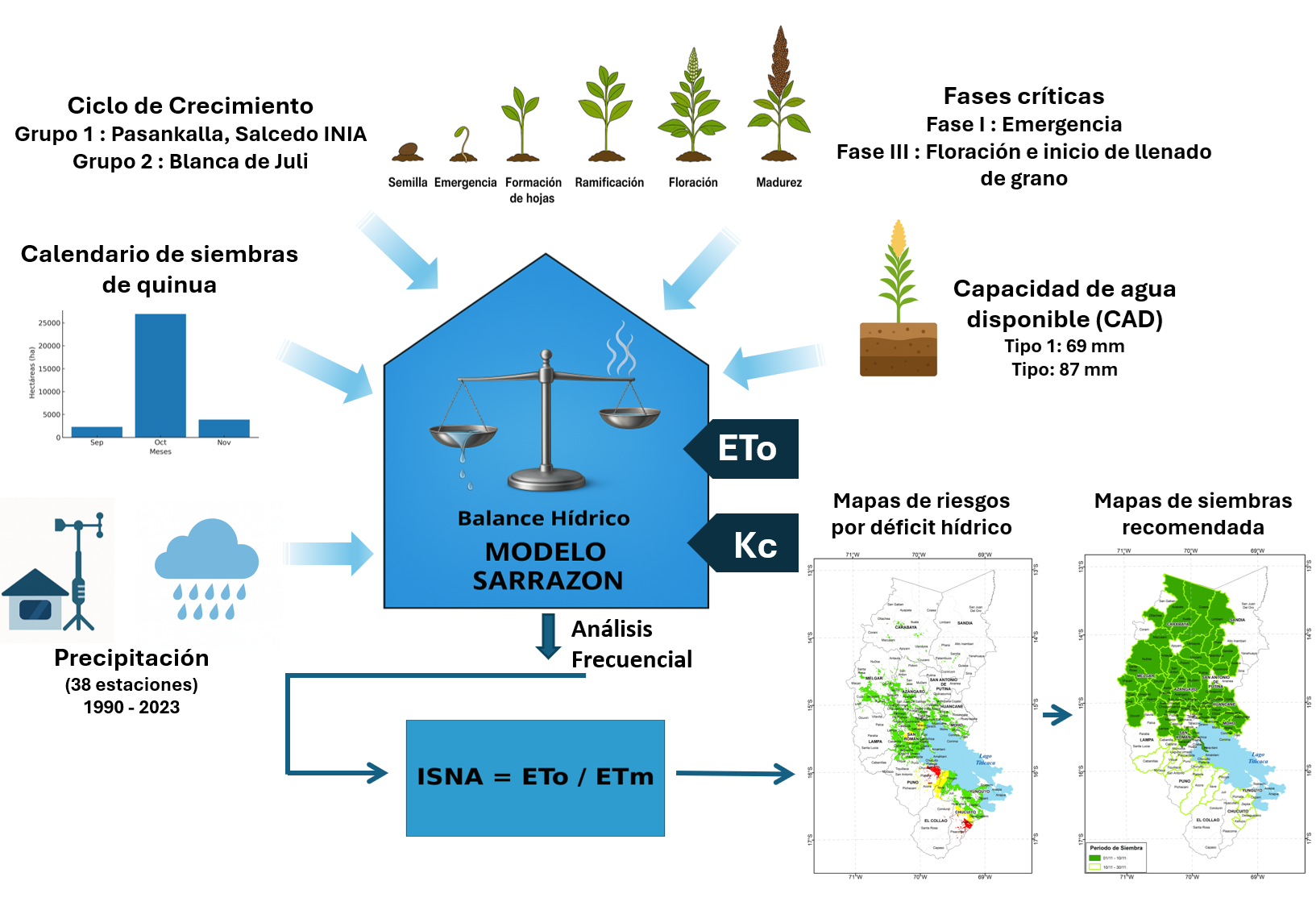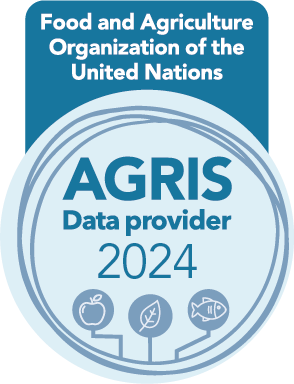Zonificación agrícola de riesgos climáticos para el cultivo de quinua (Chenopodium quinoa Willd) en el Altiplano Peruano
Agricultural zoning of climatic risks for quinoa (Chenopodium quinoa Willd) cultivation in the Peruvian Altiplano
DOI:
https://doi.org/10.17268/sci.agropecu.2026.001Keywords:
quinoa, spatial analysis, agricultural zoning, water balance, climate riskAbstract
The objective of this study was to conduct agricultural zoning of climate risk for quinoa cultivation. Data from 38 meteorological stations of the National Meteorology and Hydrology Service in Puno region were used. The zoning was based on the development of the water balance model, applying the water requirement satisfaction index (ISNA), for two levels of soil available water capacity (115 mm/m and 145 mm/m). Spatial analysis of the ETr/ETm ratio, obtained from the SARRAZON model, was carried out for each phenological stage through frequency analysis of ISNA values. These data were processed in ArcGIS10.0, using the ordinary kriging interpolation method. Once the maps were generated, they were clipped to the quinoa production zones of the region and classified as follows: for Phase I: low risk (ISNA ≥ 0.65); medium risk (0.55 < ISNA < 0.65) and high risk (ISNA ≤ 0.55), considered for the emergency stage; and for phase III the following ranges were considered: low risk (ISNA ≥ 0.55); medium risk (0.45 < ISNA < 0.55) and high risk (ISNA ≤ 0.45) during flowering and grain filling. September was identified as the month with the highest exposure to climate risk; October presented intermediate conditions; and November was the safest month, showing a predominance of low-risk zones: However, late sowing may expose the crop to critical water deficits during the final phases of quinoa cultivation.
References
Allen, R. G., Pereira, L. S., Raes, D., & Smith, M. (2006). Evapotranspiración del cultivo: Guías para la determinación de los requerimientos de agua de los cultivos (Estudio FAO Riego y Drenaje, nº 56). Organización de las Naciones Unidas para la Alimentación y la Agricultura (FAO). https://www.fao.org/3/x0490s/x0490s.pdf
Aparecido, L. E. D. O., Padua, J. M. V., Torsoni, G. B., Barboza, T. O. C., Viol, L. E. S., da Silva Cabral de Moraes, J. R., & dos Santos, A. F. (2024). Climate risk zoning for wheat crops in the southeastern region of Brazil. Journal of the Science of Food and Agriculture, 104(1), 456–467. https://doi.org/10.1002/jsfa.12943
Ballesteros, J., & Isaza, C. (2021). Adaptation measures to climate change as perceived by smallholder farmers in the Andes. Journal of Ethnobiology, 41(3), 428–446. https://doi.org/10.2993/0278-0771-41.3.428
Baron, C., Perez, P., & Maraux, F. (1996). SARRA: Système d'Analyse Régionale des Risques Agroclimatiques. Module SARRAZON: bilan hydrique appliqué au zonage. Bilan hydrique de réseaux pluviométriques et synoptiques pour des applications de zonages annuels ou pluriannuels d'analyse de risques climatiques. Guide d'utilisation.
Caldana, N. F. D. S., Nitsche, P. R., Ferreira, L. G. B., Martelócio, A. C., Zaccheo, P. V. C., & Martins, J. A. (2020). Agroclimatic risk zoning of papaya (Carica papaya L.) in the hydrographic basin of Paraná River III, Brazil. Revista Agrogeoambiental, 12(3), e1514. https://doi.org/10.18406/2316-1817v12n320201514
Canedo-Rosso, C., Hochrainer-Stigler, S., Pflug, G., Condori, B., & Berndtsson, R. (2021). Drought impact in the Bolivian Altiplano agriculture associated with the El Niño–Southern Oscillation using satellite imagery data. Natural Hazards and Earth System Science, 21, 995–1012. https://doi.org/10.5194/nhess-21-995-2021
De Oliveira Aparecido, L. E., da Silva Cabral de Moraes, J. R., de Meneses, K. C., Lorençone, P. A., Lorençone, J. A., de Olanda Souza, G. H., & Torsoni, G. B. (2020). Agricultural zoning as tool for expansion of cassava in climate change scenarios. Theoretical and Applied Climatology, 142(3), 1085–1095. https://doi.org/10.1007/s00704-020-03367-1
Dirección Regional de Agricultura de Puno – DRAP. (2023). Estadística agrícola. https://www.agropuno.gob.pe/informacion-estadistica/estadistica-agricola/
Falcón Cáceres, S. C. (2020). Determinación de la demanda hídrica y parámetros biométricos para la aplicación del riego del maíz amarillo DK7088 (Zea mays L.) en La Molina [Tesis de pregrado, Universidad Nacional Agraria La Molina]. https://hdl.handle.net/20.500.12996/4437
Gaur, M., Yadav, S., Soni, A., Tomar, D., Jangra, A., Joia, S., Kumar, A., Mehra, R., & Petkoska, A. T. (2025). Quinoa (Chenopodium quinoa Willd): Nutritional profile, health benefits, and sustainability considerations. Discover Food, 5(1), 172. https://doi.org/10.1007/s44187-025-00470-y
Gerencia Regional de Desarrollo Agrario. Serie histórica de producción agrícola de Puno. Recuperado el 15 de agosto de 2025, de https://www.agropuno.gob.pe/estadistica-agraria-informatica/agricola/
Gonçalves, S. L., & Wrege, M. S. (2020). Considerações sobre metodologias para zoneamento agrícola em escala regionalizada. Agrometeoros, 26(2). https://doi.org/10.31062/agrom.v26i2.26426
Guijarro, J. A. (2024). Guía de uso del paquete de R climatol (versión 4.1.2). https://www.climatol.eu/climatol4.1.2-es.pdf
Gutierrez-Villarreal, R. A., Espinoza, J.-C., Lavado-Casimiro, W., Junquas, C., Molina-Carpio, J., Condom, T., & Marengo, J. A. (2024). The 2022–23 drought in the South American Altiplano: ENSO effects on moisture flux in the western Amazon during the pre-wet season. Weather and Climate Extremes, 41, 100710. https://doi.org/10.1016/j.wace.2024.100710
Kalita, R., Kalita, D., & Saxena, A. (2023). Trends in extreme climate indices in Cherrapunji for the period 1979 to 2020. Journal of Earth System Science, 132(2), 74. https://doi.org/10.1007/s12040-023-02087-0
Lavarenne, J., Vaksmann, M., Affholder, F., Ferré, M., Nunes, K., Dingkuhn, M., & Baron, C. (2025). SARRA, histoire d’un modèle de simulation des cultures pour les zones intertropicales. Cahiers Agricultures, 34, 020203. https://doi.org/10.1051/cagri/2024023
Lupa-Condo, N. E., Lope-Ccasa, F. C., Salazar-Joyo, A. A., Gutiérrez-Rosales, R. O., Jellen, E. N., et al. (2024). Phenotyping for Effects of Drought Levels in Quinoa Using Remote Sensing Tools. Agronomy, 14(9), 1938. https://doi.org/10.3390/agronomy14091938
Manaa, A., Goussi, R., Derbali, W., Cantamessa, S., Essemine, J., & Barbato, R. (2021). Photosynthetic performance of quinoa (Chenopodium quinoa Willd.) after exposure to a gradual drought stress followed by a recovery period. Biochimica et Biophysica Acta (BBA)-Bioenergetics, 1862(5), 148383. https://doi.org/10.1016/j.bbabio.2021.148383
Martelócio, A. C., Caldana, N. F. S., Ferreira, L. G. B., Nitsche, P. R., & Martins, J. A. (2020). Agroclimatic risk zoning of passion fruit (Passiflora edulis Sims) in the hydrographic basin of Paraná river III, Brazil. Caminhos de Geografia, 21(77), 283–297. https://doi.org/10.14393/rcg217751951
Maturana, G. I. (2021). Efecto de la fecha de siembra en los componentes de rendimiento en genotipos contrastantes de quinoa (Chenopodium quinoa Willd) [Tesis de maestria, Pontificia Universidad Católica de Chile]. https://doi.org/10.7764/tesisUC/AGR/59542
Melo, A. D., Nobre Júnior, A. D. A., Silva, F. D., & Abreu, L. D. (2020). Zoneamento de risco climático para cultivo da soja no Cerrado. Nativa, 8(1), 26-36. https://doi.org/10.31413/nativa.v8i1.8249
Ministerio de Agricultura y Riego - MIDAGRI. (2019). Plan nacional de cultivos: Campaña agrícola 2019-2020 (323 pp.). https://repositorio.midagri.gob.pe/handle/20.500.13036/565
Ministerio de Agricultura y Riego - MIDAGRI. (2025). Sistema Integrado de Estadística Agraria. Recuperado el 18 de agosto 2025, de https://siea.midagri.gob.pe/portal/
Pulvento, C., Riccardi, M., Lavini, A., d'Andria, R., & Ragab, R. (2015). Parameterization and field validation of SALTMED Model for grain amaranth tested in South Italy. Irrigation and Drainage, 64(1), 59-68. https://doi.org/10.1002/ird.1905
Rajavel, M., Guhan, V., Vakeswaran, V., Bhuvaneswari, K., Gowtham, R., & Priyanka, S. (2022). Estimation of reference evapotrans-piration in Bhavanisagar Block of Tamil Nadu using FAO ETo calculator. International Journal of Plant & Soil Science, 34(18), 871–879. https://doi.org/10.9734/ijpss/2022/v34i1831172
Saddiq, M. S., Wang, X., Iqbal, S., Hafeez, M. B., Khan, S., Raza, A., Zahid, M. A., Yasin, G., & Gulshan, A. B. (2021). Effect of water stress on grain yield and physiological characters of quinoa genotypes. Agronomy, 11(10), 1934. https://doi.org/10.3390/agronomy11101934
Servicio Nacional de Meteorología e Hidrología del Perú - SENAMHI. (2023). Boletín pronóstico agrometeorológico de rendimiento: Cultivo de quinua. https://www.senamhi.gob.pe/load/file/0296SENA-2.pdf
Sosa‐Zuñiga, V., Brito, V., Fuentes, F., & Steinfort, U. (2017). Phenological growth stages of quinoa (Chenopodium quinoa) based on the BBCH scale. Annals of Applied Biology, 171(1), 117–124. https://doi.org/10.1111/aab.12358
Taaime, N., Rafik, S., El Mejahed, K., Oukarroum, A., Choukr-Allah, R., Bouabid, R., & El Gharous, M. (2023). Worldwide develop-ment of agronomic management practices for quinoa cultivation: A systematic review. Frontiers in Agronomy, 5, 1215441. https://doi.org/10.3389/fagro.2023.1215441
Taaime, N., El Mejahed, K., Moussafir, M., Bouabid, R., Oukarroum, A., Choukr-Allah, R., & El Gharous, M. (2022). Early sowing of quinoa cultivars benefits from rainy season and enhances quinoa development, growth, and yield under arid condition in Morocco. Sustainability, 14(7), 4010. https://doi.org/10.3390/su14074010
Valdivia-Cea, W., Bustamante, L., Jara, J., Fischer, S., Holzapfel, E., & Wilckens, R. (2021). Effect of soil water availability on physiological parameters, yield, and seed quality in four quinoa genotypes (Chenopodium quinoa Willd.). Agronomy, 11(5), 1012. https://doi.org/10.3390/agronomy11051012

Downloads
Published
How to Cite
Issue
Section
License
Copyright (c) 2025 Scientia Agropecuaria

This work is licensed under a Creative Commons Attribution-NonCommercial 4.0 International License.
The authors who publish in this journal accept the following conditions:
a. The authors retain the copyright and assign to the magazine the right of the first publication, with the work registered with the Creative Commons attribution license, which allows third parties to use the published information whenever they mention the authorship of the work and the First publication in this journal.
b. Authors may make other independent and additional contractual arrangements for non-exclusive distribution of the version of the article published in this journal (eg, include it in an institutional repository or publish it in a book) as long as it clearly indicates that the work Was first published in this journal.
c. Authors are encouraged to publish their work on the Internet (for example, on institutional or personal pages) before and during the review and publication process, as it can lead to productive exchanges and a greater and faster dissemination of work Published (see The Effect of Open Access).




